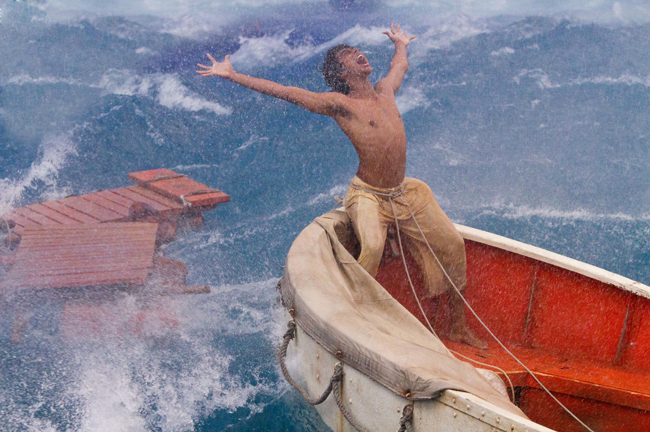To call “Life of Pi” a challenging novel to adapt would be an understatement. It is a deeply emotional work where much of the conflict is internal and much of the action consists of a boy and a tiger floating around on a life raft. However, director Ang Lee tackles the project with an unabashed earnest streak and a tendency to revel in the beauty of his images and settings, turning what could have been a snooze into a gripping, inspiring and occasionally frustrating tale of survival.
The film plays out mostly in flashback as an adult Pi (Irrfan Khan) relates his tale to a writer (Rafe Spall). Pi’s story goes back to his childhood, which he spent in a zoo his family operated in India. When his father decides to move the family to America and sell the zoo, the voyage across the sea proves fateful. The ship is wrecked, and Pi ends up in a lifeboat with a tiger named Richard Parker.
Young Pi is played by Suraj Sharma, an untested actor, on screen for the first time here. Thankfully, Sharma gives a touching, likable performance and manages to instill the languorous middle chunk of the film with some dramatic edge. Sharma also manages to sell Pi’s interactions with a mostly CGI tiger and makes it easy for the audience to invest in this simple but totally irrational relationship. It’s a shockingly accomplished work and a strong debut for Sharma.
But the film’s real star is Lee. The director has flitted around different genres of Hollywood throughout his career, but “Life of Pi” is a wonderful match of director and material. Lee brings a delicate, introspective sensibility to the film, but never allows the middle section, which is entirely Pi and Richard Parker afloat at sea, to become boring or repetitive. Instead, he brings some of the most beautiful, indelible images of the year to the screen, and makes “Life of Pi” a visual feat. Also worth mentioning is the stunning, massively scaled shipwreck Lee stages early in the film, a marvelous demonstration of nature’s power invested with real human (and animal) stakes.
In adapting “Life of Pi,” one must approach the film’s ending with care. Many a high schooler has thrown their copy of the book across the room once everything starts to come into focus, and I could feel myself becoming less and less charmed with “Life of Pi” as I started to realize where the film was going. Without giving it away, things take a sharp left turn toward the end, and much of the resonance of Pi’s journey is stripped away, replaced with something much uglier. There’s a lot to discuss, and the ending has undeniable dramatic merit but seems to be unsatisfying by design. Early on, Pi says his story will make you believe in God, and that’s a tough bar for the film to clear, even without its unapologetic cheat of an ending.
“Life of Pi” may be too empty in the long run to fully satisfy, but it is still commendable for making something compelling out of a sparse premise and setting. It’s a heady, bold experience and an emotionally gripping, visually stunning adventure in the truest sense of the word.





















